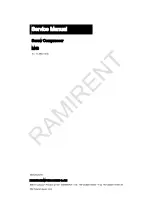
General installation and maintenance instructions
SCROLL ENCLOSURE AIR COMPRESSOR
Page 7 / 22
09/2007
Manual N° 5.18396. VERSION 0 - GB
4.2. Ventilation
If the scroll compressor is located in a totally enclosed room, an exhaust fan with access to outside air must be installed.
Never restrict the cooling fan exhaust air.
Vent the exhaust air outside to prevent the compressor from operating at high temperatures and shutting down.
Never locate the compressor where hot exhaust air from other heat generating units may be pulled into the unit.
4.2.1.
Suggested ventilation system
1.
The following ventilation capacity is designed to keep the temperature rise inside the room to be max. 10°F. Since
the calculation is based on zero static pressure, the actual ventilation capacity should be larger than the figure in
Chart 1.
2.
Install the exhaust duct in order to minimize the pressure lost of the ducting. Keep the distance between the inlet
duct and the compressor exhaust to be at least 0.3 meter for ease of maintenance. Intake section of the duct
should be larger than the dimension of compressor exhaust shown below:
Model
42 SP2
63 SP2
84 SP2
Ventilation capacity (m³/h)
1560 2287 3120
Chart 1
4.3. Wiring
All electrical hook-ups must be performed by a qualified electrician. Installations must be in accordance with local and
national electrical codes.
•
Use solderless terminals to connect the electric power source.
•
Remove front panel.
•
Remove the rectangle electrical box cover located beneath air inlet filter on the right front of the unit.
•
Connect the power inlet cable to the inlet power junction block located on the inlet side of all starter connections.
Consult your NEC and local codes for wire size.
4.4. Piping
These units do not include air receivers. An air receiver can be purchased separately. Please consult our distributors.
•
Make sure the piping is lined up without being strained or twisted when assembling the piping for the scroll
compressor.
•
Appropriate expansion loops or bends should be installed at the compressor to avoid stresses caused by changes in
hot and cold conditions.
•
Piping supports should be anchored separately from the compressor to reduce noise and vibration.
•
Never use any piping smaller than the compressor connection.
•
Use flexible hose to connect the outlet of the compressor to the piping so that the vibration of the compressor does
not transfer to the piping.
4.5. Safety
valves
Tank must be equipped with safety valves in the air receiver manifold. The flow capacity of the safety valve is equal to or
greater than the capacity of the compressor.
•
The pressure setting of the safety valve must not be greater than the maximum working pressure of the air receiver.
•
Safety valves should be placed ahead of any possible blockage point in the system, i.e. shutoff valve.
•
Avoid connecting the safety valve with any tubing or piping.
•
Manually operate the safety valve every six months to avoid sticking or freezing.
SECTION 5.
OPERATION
5.1. Before
start-up
•
Make sure all safety warnings, labels and instructions have been read and understood before continuing.
•
Remove any shipping materials, brackets, etc.
•
Confirm that the electric power source and ground have been firmly connected.
•
Check the belts for tightness.
•
Be sure all pressure connections are tight.
•
Check to be certain all safety relief valves, etc., are correctly installed.









































